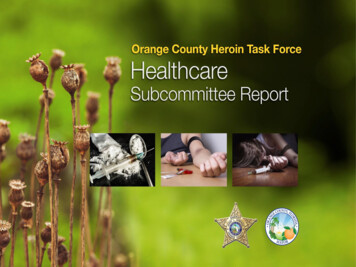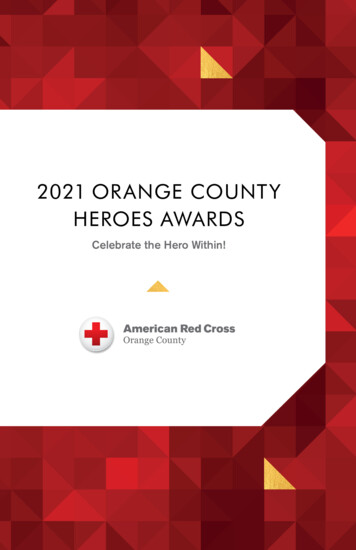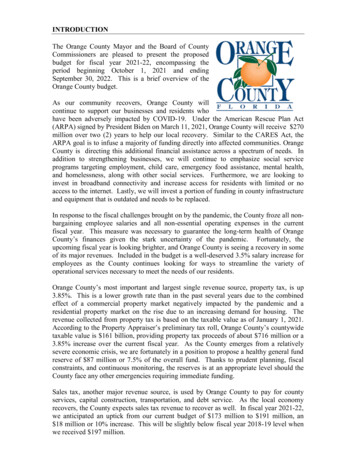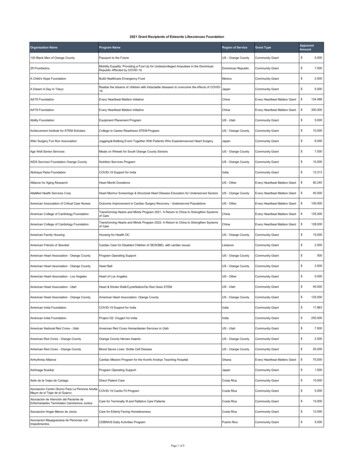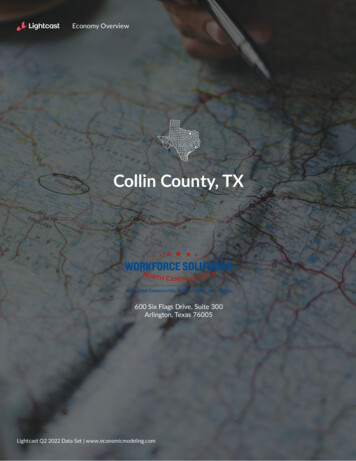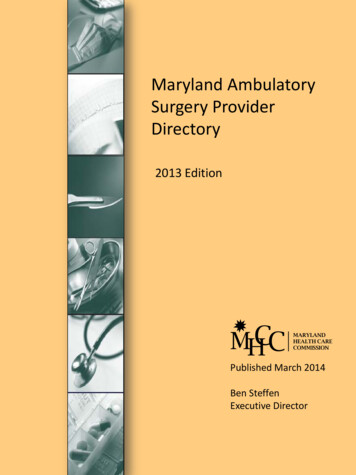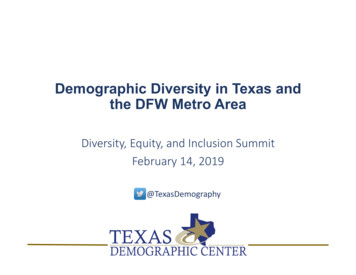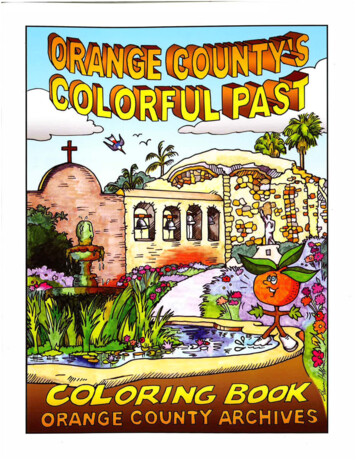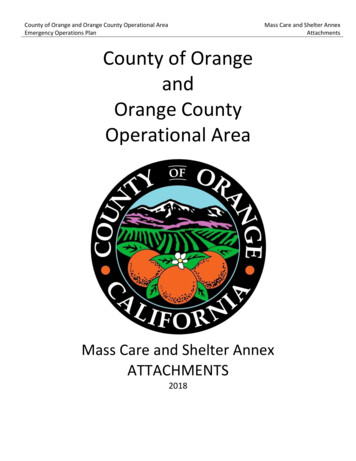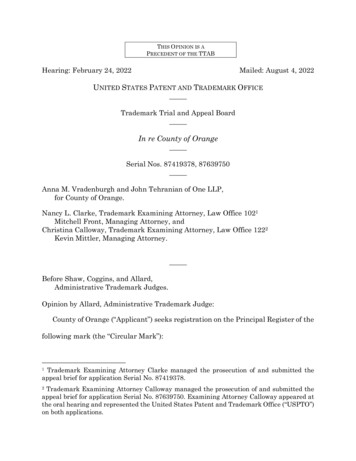
Transcription
THIS OPINION IS APRECEDENT OF THE TTABHearing: February 24, 2022Mailed: August 4, 2022UNITED STATES PATENT AND TRADEMARK OFFICETrademark Trial and Appeal BoardIn re County of OrangeSerial Nos. 87419378, 87639750Anna M. Vradenburgh and John Tehranian of One LLP,for County of Orange.Nancy L. Clarke, Trademark Examining Attorney, Law Office 1021Mitchell Front, Managing Attorney, andChristina Calloway, Trademark Examining Attorney, Law Office 1222Kevin Mittler, Managing Attorney.Before Shaw, Coggins, and Allard,Administrative Trademark Judges.Opinion by Allard, Administrative Trademark Judge:County of Orange (“Applicant”) seeks registration on the Principal Register of thefollowing mark (the “Circular Mark”):Trademark Examining Attorney Clarke managed the prosecution of and submitted theappeal brief for application Serial No. 87419378.1Trademark Examining Attorney Calloway managed the prosecution of and submitted theappeal brief for application Serial No. 87639750. Examining Attorney Calloway appeared atthe oral hearing and represented the United States Patent and Trademark Office (“USPTO”)on both applications.2
Serial Nos. 87419378, 87639750for a wide range of services in seven classes, including: county government services, namely, providing information in the field ofgovernment affairs, in International Class 35; maintaining parks, libraries, county offices, harbors and airports, namely,building maintenance, in International Class 37; running and maintaining public services, namely, providing transport andstorage of waste, in International Class 39; county government services in the nature of education and entertainmentservices, such as, providing sport facilities and libraries, in International Class41; environmental testing and inspection services, evaluation and testing of realestate for the presence of hazardous material, in International Class 42; providing public health care services, in International Class 44; and providing law enforcement services, namely, police and civil protectionservices, in International Class 45.3Applicant also applied to register the mark shown below (the “Badge Mark”):Application Serial No. 87419378 (the “’378 application”) was filed on April 20, 2017, underSection 1(a) of the Trademark Act, 15 U.S.C. § 1051(a), based upon Applicant’s claim of firstuse anywhere since 1952 and in commerce since 1965 in all classes.3Applicant describes the mark in the application as follows: “The mark consists of a circlesurrounding the words ‘COUNTY OF ORANGE’ on the top and ‘CALIFORNIA’ on the bottomwith an image of a mountain, a field and three oranges set in the middle.” Color is not claimedas a feature of the mark.Applicant disclaims the exclusive right to use the wording “COUNTY OF ORANGECALIFORNIA.”-2-
Serial Nos. 87419378, 87639750for services in International Classes 35 and 41, which are similar to those identifiedin Classes 35 and 41 in the application to register the Circular Mark.4 Notably, theBadge Mark incorporates the Circular Mark in its entirety.With regard to the application to register the Circular Mark, the TrademarkExamining Attorney refused registration of it under Trademark Act Section 2(b), 15U.S.C. § 1052(b), because the mark consists of the insignia of a municipality.5 TheApplication Serial No. 87639750 (the “’750 application”) was filed on October 10, 2017, underSection 1(a) of the Trademark Act, 15 U.S.C. § 1051(a), based upon Applicant’s claim of firstuse anywhere and in commerce since 1982 in both classes.4Applicant describes the mark in the application as follows: “The mark consists of a circle withthe image of three oranges in front of an orange grove and snow-covered mountains with thewords ‘COUNTY OF ORANGE’ in an arc above the circle and the word ‘CALIFORNIA’ belowthe circle. Above the circle in a banner are the words ‘PARK RANGER’ and below the circleare the words ‘PARKS-BEACHES’ inside of a banner. All of the aforementioned is inside of abadge shape with the encompassed wording and design superimposed over a half wreath.Inside of the bottom of the shield shape is a geometric shape and at the top of the shield shapeare multiple connected quadrilaterals.” Color is not claimed as a feature of the mark.Applicant disclaims the exclusive right to use the wording “PARK RANGER PARKSBEACHES COUNTY OF ORANGE CALIFORNIA.”March 3, 2018 Office Action at 2 in the ’378 application to register the Circular Mark.Citations are to the record in the ’378 application, unless otherwise noted.5Page references to the application records refer to the downloadable version of documentsfrom the USPTO’s Trademark Status & Document Retrieval system. See, e.g., In re PeaceLove World Live, LLC, 127 USPQ2d 1400, 1402 n.4 (TTAB 2018). References to the briefs onappeal refer to the Board’s TTABVUE docket system. The docket entry number appearsbefore the TTABVUE designation, and the page references, if applicable, appear after it.-3-
Serial Nos. 87419378, 87639750refusal was subsequently withdrawn6 but later reinstated7 and made final.8 Whenthe refusal was made final, Applicant appealed and requested reconsideration.9 Afterthe Examining Attorney denied the request for reconsideration,10 the appealresumed.With regard to the application to register the Badge Mark, the ExaminingAttorney refused registration of the mark under Section 2(b) of the Trademark Act,15 U.S.C. § 1052(b).11 Applicant argued against the refusal, which was thenwithdrawn, and a Notice of Publication issued.12 However, the Examining Attorneysubsequently requested that jurisdiction of the application be restored,13 and therefusal to register under Section 2(b) was reinstated.14 When the refusal was madefinal,15 Applicant appealed and requested reconsideration.16 After reconsiderationwas denied,17 the appeal resumed.6October 31, 2019 Office Action at 2.7May 7, 2020 Office Action at 2-3.8December 17, 2020 Office Action at 2.9June 15, 2021 Request for Reconsideration after Final (“Req. Recon.”).10July 26, 2021 Denial of Req. Recon at 1-2.11August 17, 2018 Office Action in the ’750 application.12October 30, 2019 Notice of Publication in the ’750 application.13January 15, 2020 Administrative Response in the ’750 application.14January 24, 2020 Office Action in the ’750 application.15August 10, 2020 Office Action in the ’750 application.16February 5, 2021 Req. Recon in the ’750 application.17May 17, 2021 Denial of Req. Recon in the ’750 application.-4-
Serial Nos. 87419378, 87639750The appeals are fully briefed. At Applicant’s request, the appeals wereconsolidated prior to oral argument.18 We now decide them in this single opinion, seeIn re Mr. Recipe, LLC, 118 USPQ2d 1084, 1085 (TTAB 2016) (Board consolidatedappeals in two applications on Examining Attorney’s request and issued a singleopinion), and affirm the refusals to register.I.The Circular Mark of the ’378 ApplicationBefore addressing the merits, we first address an evidentiary matter.A.Evidentiary MatterApplicant attaches to its appeal brief a copy of a portion of the constitution of theState of California.19 In her brief, the Examining Attorney does not object to the newevidence nor does she discuss it or otherwise treat it as being of record. Generally,under such circumstances, such evidence could be excluded from consideration. In rePedersen, 109 USPQ2d 1185, 1188 (TTAB 2013) (refusing to consider late-filedevidence submitted with appeal brief even though examining attorney did notexplicitly object to the evidence, because examining attorney did not discuss it orotherwise treat it as being of record). However, in this instance, the evidence is notsubject to reasonable dispute and therefore we may take judicial notice of it.TRADEMARK TRIAL AND APPEAL BOARD MANUAL OF PROCEDURE § 704.12(a) (2022) andcases cited therein.Board Order dated December 16, 2021 appearing at 13 TTABVUE in the ’378 application,and 25 TTABVUE in ’750 application.1819Exhibit to Applicant’s brief (7 TTABVUE 26).-5-
Serial Nos. 87419378, 87639750B.BackgroundThe California Government Code states that a county may adopt a seal, but to doso requires the completion of a two-step process.20 First, the seal must be adopted bythe county Board of Supervisors and, second, “[a] description and impression of theseal shall be filed in the office of the county clerk.”21 Simply put, in order for a seal tobecome a county’s official seal, “it must be adopted by the Board of Supervisors, andit must be filed with the county clerk.”22Applicant made of record evidence that it, County of Orange, California, createdand adopted an “official” seal over a century ago.23 The official seal generally consistsof a single orange having a stem with three leaves, as shown in one of its coloriterations below:2420Cal. Gov’t Code § 25004 attached to the May 16, 2019 Response to Office Action at 10.Id.; Declaration of Thomas A. Miller, para. 2 (“Miller Decl.”), attached to the June 15, 2021Req. Recon. at 37.2122Applicant’s brief, p. 9 (7 TTABVUE 10).Declaration of Chris Jepsen, para. 2 (“Jepsen Decl.”) attached to the June 15, 2021 Req.Recon. at 36; Minutes of August 5, 1889 Board of Supervisors meeting, para. 3, attached asExhibit 1 to the August 29, 2018 Response to Office Action at 5.23Jepsen Decl., paras. 2, 4 attached to the June 15, 2021 Req. Recon. at 36; Miller Decl., para.3, attached to the June 15, 2021 Req. Recon. at 37; image of “official” seal is shown in theNovember 6, 2020 Response to Office Action at 16. Additional images containing this emblemin different colors are shown in the November 6, 2020 Response to Office Action at 67-68.24-6-
Serial Nos. 87419378, 87639750The image of a single orange having a stem with three leaves became “the emblemfor all seals of Orange County,” excepting the seal of the Superior Court, by motionat a meeting of the Board of Supervisors on August 5, 1889, and, according to theminutes of that meeting, the design was proposed and “carried unanimously”.25According to Cynthia J. Sandoval, the Board Services Specialist for the Clerk ofthe Board of Supervisors for Applicant, this single orange design is and has been theonly “official” seal of the County.26 There is no other “official” seal.27 That is, the“official” seal has not been supplanted or discarded by the County.28The “official” seal of Applicant as compared to the proposed Circular Mark isshown below:Official SealCircular MarkMinutes of August 5, 1889 Board of Supervisors meeting, para. 3, attached as Exhibit 1 tothe August 29, 2018 Response to Office Action at 5.25Declaration of Cynthia J. Sandoval, paras. 1, 3 at 11, attached to the May 16, 2019Response to Office Action at 11.26Id. at para. 3. While the evidence indicates that the orange-stem-leaves design was adoptedas the emblem for all seals of Orange County (except one, i.e., the seal of the Superior Court),and Applicant made of record multiple County seals, for purposes of these consolidatedappeals we accept arguendo Applicant’s position that the orange-stem-leaves emblem is theone “official” seal of Orange County.2728Jepsen Decl., para. 2, attached to the June 15, 2021 Req. Recon. at 36.-7-
Serial Nos. 87419378, 87639750C.AnalysisSection 2(b) of the Trademark Act, 15 U.S.C. § 1052(b), prohibits registration oneither the Principal or Supplemental Register of a mark that “[c]onsists of orcomprises the flag or coat of arms or other insignia of the United States, or of anyState or municipality, or of any foreign nation, or any simulation thereof.” Thissection imposes an absolute bar against registration of a mark that consists of orcontains a flag, coat of arms or other insignia, and reflects the sentiment that suchsymbols are indicia of government authority that ought to be reserved for signifyingthe government. In re Gov’t of Dist. of Columbia, 101 USPQ2d 1588, 1597 n.14 (TTAB2012), aff’d sub nom. In re City of Houston, 731 F.3d 1326, 108 USPQ2d 1226 (Fed.Cir. 2013).“The registration bar was not enacted to protect official prerogatives or preserveofficial symbols from desecration. Rather, the bar represents a more generaldetermination that [government] insignia are not appropriate subjects of trademarklaw at all. Trademark law concerns itself with goods and services in commerce.”Renna v. Cnty. of Union, 88 F. Supp. 3d 310, 324 n.9 (D.N.J. 2014). As a leadingauthority on trademark law explains, the absolute bar to registration under Section2(b) is founded upon the idea that “these kinds of official governmental insignia . . .should not be registered as symbols of origin for commercial goods and services[ ]”because they “ought to be kept solely to signify the government”. 3 J. THOMASMCCARTHY, MCCARTHYONTRADEMARKSAND2022).-8-UNFAIR COMPETITION § 19:78 (5th ed.
Serial Nos. 87419378, 87639750Applicant argues that the proposed mark does not constitute “insignia” because itis not an “official” seal of Applicant, and, even if it were, registration is not precludedbecause Applicant is not a “municipality.”29 We consider each argument in turn.1.The Circular Mark Constitutes “Insignia”The record contains multiple definitions of the term “insignia”, which is definedas both “a distinguishing mark or sign”30 and “an emblem.”31 “Emblem” is defined as“a device, symbol, or figure adopted and used as an identifying mark.”32Although the Circular Mark has not undergone the two-step process to become an“official” seal,33 it is displayed prominently by Applicant to signify broad County ofOrange authority, records, functions and facilities. For example, the earliest displayof the proposed mark can be traced back to its appearance on the cover of a 1948 bookof County of Orange ordinances.34Additionally, Applicant displays the proposed mark on its website. As shownbelow, the proposed mark appears prominently at the top and bottom of the site (here29Applicant’s brief, pp. 1, 2-18 (7 TTABVUE 2, 3-19).MERRIAM-WEBSTER DICTIONARY (merriam-webster.com) definition attached to theNovember 27, 2018 Office Action at 62.30AMERICAN HERITAGE DICTIONARY (ahdictionary.com) definition attached to the November27, 2018 Office Action at 68.31MERRIAM-WEBSTER DICTIONARY definition accessed on May 12, 2021. The Board may takejudicial notice of dictionary definitions, including online dictionaries that exist in printedformat or have regular fixed editions, and we do so here. In re Cordua Rests. LP, 110 USPQ2d1227, 1229 n.4 (TTAB 2014), aff’d, 823 F.3d 594, 118 USPQ2d 1632 (Fed. Cir. 2016).3233Jepsen Decl., para. 3, attached to the June 15, 2021 Req. Recon. at 36.34Id.-9-
Serial Nos. 87419378, 87639750describing Applicant’s shelters35) and in each of the three email subscription boxeson the right, as indicated by the arrows:35May 7, 2020 Office Action at 7-8.- 10 -
Serial Nos. 87419378, 87639750From this webpage, one can click a link to access information about otherApplicant services, such as business licenses, and to pay/view a property tax bill.36Applicant also displays its proposed Circular Mark on its “About the Board” webpagedescribing the Orange County Board of Supervisors,37 which is described as anauthoritative body charged with “oversee[ing] the management of the Countygovernment and its many special districts. . . . [and, i]n its legislative duties, . . .adopt[ing] ordinances, resolutions and minute orders within the limits prescribed byState law.”38The Circular Mark also appears on the website for the Clerk-Recorder’s office. TheClerk-Recorder’s office manages many official government documents, includingproperty records, marriage licenses, and birth and death certificates, and it performsmarriage ceremonies.39Additionally, the proposed mark is displayed prominently on signage for Countyof Orange government offices, such as the Hall of Administration, which houses,among other things, the Board of Supervisors.40 The proposed mark appears on othersignage for the Old Orange County Courthouse,41 the Hall of Records and Hall of36Id.37Id. at 20-25.38Id. at 21.39Id. at 10.40Id. at 11.41Id. at 12.- 11 -
Serial Nos. 87419378, 87639750Finance,42 the Superior Court of California,43 and the Orange County Sherriff.44 Theproposed mark is shown below on the website for the Orange County Clerk-Recorder’soffice, which itself shows the proposed mark on the Clerk-Recorder’s roadwaysignage:4542Id. at 13-15.43Id. at 16.44Id. at 17.45Id. at 10.- 12 -
Serial Nos. 87419378, 87639750Below is a representative screen shot of the proposed mark used on signage todenote County of Orange facilities, such as the Superior Court of California:46Additionally, the proposed mark is prominently displayed on the wall of themeeting room for the Orange County Board of Supervisors,47 as shown in thisphotograph which appeared in an online article reporting on the Board of Supervisors’activities:4846Id. at 16.47Id. at 19, 26.48Id. at 26.- 13 -
Serial Nos. 87419378, 87639750Still further, the proposed mark is shown on a map for the Orange County (OC)Civic Center, which depicts the name, address and location of various governmentfacilities by color: Applicant facilities in orange, city facilities in green, state facilitiesin blue, and federal facilities in black.49 The County of Orange facilities indicated onthis map reflect functions that are traditionally and uniquely provided by agovernment: the district attorney’s office, the health care agency and vital recordsoffice, the law library, the men’s and women’s jail, the coroner’s office, the Old County49Id. at 28.- 14 -
Serial Nos. 87419378, 87639750Courthouse, the Hall of Administration, and the sheriff forensic science servicesbuilding.50Similarly, the proposed mark appears on a map showing the Orange CountyGeneral Plan – a map that illustrates land-use designations, such as ruralresidential, suburban residential, urban residential, commercial and the like:5150Id.51Id. at 29.- 15 -
Serial Nos. 87419378, 87639750Based on the foregoing discussion and evidence, we find that the prominent andrepeated display of the proposed Circular Mark to denote traditional governmentrecords, functions, and facilities would reasonably lead members of the general publicto perceive the proposed mark as an “insignia” of Applicant within the meaning ofSection 2(b) of the Trademark Act. As shown above, the proposed mark serves as “adistinguishing mark or sign”52 and an “emblem” of Applicant’s authority.53 Althoughthe proposed mark has not been adopted as an “official” seal of Applicant, this does52MERRIAM-WEBSTER DICTIONARY attached to the November 27, 2018 Office Action at 62.53AMERICAN HERITAGE DICTIONARY attached to the November 27, 2018 Office Action at 68.- 16 -
Serial Nos. 87419378, 87639750not preclude its functioning as an insignia within the meaning of Section 2(b) of theTrademark Act. Notably, Section 2(b) does not distinguish between “official” and“unofficial” insignia. That is, formal adoption is not required for insignia to fall underthe prohibition of Section 2(b) based on a literal reading of the Act.Applicant argues that if the Office’s position were to prevail, it would effectivelydictate the official seal of the County of Orange, which would contradict the will ofApplicant and its governing Board of Supervisors, with whom that power is vested.54We disagree. Our decision as to whether the proposed Circular Mark constitutes an“insignia” under the Trademark Act has no effect on any actions by the Board ofSupervisors in its decision to adopt (or not) an official seal. The Trademark Trial andAppeal Board is an administrative tribunal of the USPTO empowered to determinethe right of a party to register its proposed mark. Trademark Act §§ 17, 18, 20, 24, 15U.S.C. §§ 1067, 1068, 1070, 1092. See Conolty v. Conolty O’Connor NYC LLC, 111USPQ2d 1302, 1309 (TTAB 2014) (registration is the only issue within the Board’slimited jurisdiction). The Board has no authority to dictate the official seal ofApplicant and does not purport to do so. With this decision, we merely determine thatthe proposed mark constitutes an insignia within the meaning of Section 2(b) of theTrademark Act for purposes of federal registration.54Applicant’s brief, p. 11 (7 TTABVUE 12).- 17 -
Serial Nos. 87419378, 876397502.Applicant Is a “Municipality” for Purposes of Section 2(b) of theTrademark ActAs previously mentioned, Section 2(b) of the Trademark Act bars registration ofan insignia “of any state or municipality of the United States .” 15 U.S.C.§ 1052(b) (emphasis added); see Ceccato v. Manifattura Lane Gaetano Marzotto &Figli, S.p.A., 32 USPQ2d 1192, 1196 (TTAB 1994) (noting that “it would appear thatthe reference to ‘municipality’ in the Statute is to a municipality in the UnitedStates”).Applicant identifies itself in the record by name as County of Orange and as apolitical subdivision of the state of California.55The Examining Attorney made of record evidence that the term “municipality”means “[a] political unit, such as a city, town, or village, that is incorporated for localself-government.”56 Relying on website printout evidence from ballotpedia.org, theExamining Attorney argues that this evidence shows Orange County, California tobe a “charter county of the state which the state recognizes as its own governmentalbody upon adoption of a charter .”57 The Examining Attorney also argues thatApplicant meets the definition of “municipality,” as the evidence from Applicant’s ownwebsite establishes that Applicant is a local governmental authority.58 Continuing,the Examining Attorney argues that “[e]ven if applicant is not technically a55Application at 1.56November 27, 2018 Office Action at 7.57December 17, 2020 Office Action at 3.58Id. at 3.- 18 -
Serial Nos. 87419378, 87639750municipality, the evidence of record from applicant’s own website, ocgov.com,establishes that applicant is a local governmental entity functioning as such.”59Applicant argues that it is not a “municipality” under the definition proffered bythe Examining Attorney (as counties are not “incorporated” for local self-government,among other reasons) or under California state law. Applicant argues that:Despite the overwhelming authority that renders the Office’s positionuntenable, the Office has nevertheless repeatedly and baldly asserted thatOrange County is a municipality. There is no logical or legal basis tosupport this position, so the Office has clung to this assertion with an illfounded reliance on websites lacking credibility, and a misinterpretation ofthe effect of a county’s adoption of a charter. Specifically, the Office cites anunvetted, third-party website known as ballotpedia.org. The site listsOrange County, California as a charter county of the state, which the Officeargues “recognizes as its own governmental body upon adoption of acharter and the subsequent evidence citing Section 3, Article XI of theCalifornia Constitution specifies the provisions for such charter counties.”While this statement is irrelevant to whether the County of Orange is amunicipality, the Office further defines “’municipality’ as ‘a political unit,such as a city, town, or village, incorporated for local self-government’”and argues the “evidence from ocgov.com establishes applicant is a localgovernmental agency under the common definition of ‘municipality.’” Id.The conclusion drawn by the Office demonstrates a misunderstanding ofwhat is meant by the State’s recognition of a charter adopted by a county,and the issue of ‘self-government,’ as it pertains, or does not pertain, to acounty that chooses to adopt a charter. Further, the Office misstates theCalifornia Constitution.A municipality is defined as “a municipal corporation: a city, town,borough, or incorporated village.” Applicant is the County of Orange, acounty in the State of California. Unlike a city (municipality), it is notincorporated for local self-government; rather, it is formed specifically bylegislative enactment from the State. A county is not a municipalcorporation, or any of the listed bodies identified in the definition ofmunicipality. Consistent with the above definition, the California SupremeCourt has made clear, “[a] county is not a corporation for municipalpurposes, within the meaning of section 7 of article XI of the constitution.”Kahn v. Sutro, 114 Cal. 316, 319 (1886). This view is also consistent with59Examining Attorney’s brief (9 TTABVUE 5).- 19 -
Serial Nos. 87419378, 87639750(1) the dictionary definition offered by the Office itself; (2) the case lawwhich is replete with numerous reported decisions that have held that useof the term “municipality” does not encompass counties, see, e.g., Einer v.Rivera, 346 P3d 1197, 1204 (Ct. App. N.M. 2015) (“Although there may becertain overlap or parallel governing principles with respect tomunicipalities and counties, and our courts have at times referred tomunicipalities and counties in a common way, the two are not the same.”);and (3) leading treatises, see, e.g., 1 EUGENE MCQUILLIN, THE LAW OFMUNICIPAL CORPORATIONS, § 2:45, at 283, 286 (3d 2010) (“[MunicipalCorporations] and counties have been declared to be separate and distinctlegal entities. . . [T]he county is not, strictly speaking, a municipalcorporation”). Municipalities are cities, and a county is—quite simply andunequivocally—not a city.60Even assuming, as Applicant argues, that (1) Applicant was formed by specificlegislative enactment,61 (2) Applicant chose to enact a charter on March 5, 2002, longafter Applicant was formed by specific legislative enactment,62 (3) the CaliforniaConstitution allows a county to adopt a charter after formation under certainconditions,63 and (4) a county may not be considered a “municipality” under Californialaw,64 none of this impacts our decision.For purposes of interpreting Section 2(b) of the Trademark Act, the exact natureof the formation of Applicant, i.e., whether by specific legislative enactment orotherwise, Applicant’s adoption or not of a charter and the timing of any suchadoption, and whether or not Applicant was “incorporated” for self-government, are60Applicant’s brief, p. 3-4 (7 TTABVUE 4-5) (some citations omitted).61Id. at 4 (7 TTABVUE 5).Id.; Miller Decl., para. 5, attached to the June 15, 2021 Req. Recon. at 38. The OrangeCounty Charter is attached as Exhibit 15 to the June 15, 2021 Req. Recon. at 93-97.6263Applicant’s brief, p. 4 (7 TTABVUE 5).Kahn v. Sutro, 114 Cal. 316, 319 (1886) attached as Exhibit 22 attached to the June 15,2021 Req. Recon. at 257-70.64- 20 -
Serial Nos. 87419378, 87639750irrelevant. The fact remains that Applicant has some powers of self-government, asdemonstrated by the evidence above and as discussed further below.As an initial matter, we take judicial notice of a different definition of the term“municipality.” BLACK’S LAW DICTIONARY defines “municipality” as:1. A city, town, or other local political entity with the powers of selfgovernment.65Applicant’s own evidence acknowledges that the California Constitution itselfprovides that a county may have some powers of self-government. For example, the“California Constitution authorizes a county to make and enforce local ordinancesthat do not conflict with general laws. A county also has the power to sue and be sued, and levy and collect taxes authorized by law.”66 Further, Section 3 of the California65BLACK’S LAW DICTIONARY (11th ed. 2019).66Exhibit 16 attached to the November 6, 2020 Response to the Office Action at 87.Indeed, in a law review article by Jared Eigerman, the Deputy City Attorney for the City andCounty of San Francisco, California, Mr. Eigerman wrote that his article “examinesCalifornia’s most basic form of local government, the county.” Eigerman, CaliforniaCounties: Second-Rate Localities or Ready-Made Regional Governments?, 26 Hastings Const.L.Q. 621, 626 (1999) (emphasis added). Mr. Eigerman also wrote that California “countieshave their own source of power. They have a tax base and their own identifiableconstituency.” Id. at 626.As for the distinction between cities and counties, Mr. Eigerman writes:In 1850, after creating counties, the California Legislature acted to allow theincorporation of cities. Today’s State Constitution commands the Legislatureto prescribe a uniform procedure for city formation and provide for city powers.However, the State Constitution does not mandate the creation of cities, as itdoes of counties. Instead, county residents must themselves petition forincorporation as a city. California’s over 450 cities are “municipalcorporations,” formed for the purposes of local government, and, unlikecounties, they are not subdivisions of the State. The Legislature has authorizedcities to exercise powers that are often identical to those of counties. The resultis that counties are left to exercise their powers only in unincorporated portionsof their territories.Id. at 629-30.- 21 -
Serial Nos. 87419378, 87639750Constitution provides that “For its own government, a county or city may adopta charter by majority vote of its electors voting on the question.”67 Thus, on its face,it appears that the California Constitution contemplates that a county shall havesome form of local “powers of self-government.”Further, Thomas A. Miller, Applicant’s Chief Real Estate Officer and otherwiselong-time employee of Applicant, acknowledged that Applicant elected to enact acharter because it “was motivated by the desire to have the ability to amend a verylimited number of governing laws, including retirement and pension benefits, andestablishing a Campaign Finance and Ethics Commission.”68 Amending one’s owngoverning laws is a form of “self-government” as it constitutes controlling one’s ownaffairs,69 even if it is limited in some ways.Additionally, Applicant’s own website broadly describes the functions of the Boardof Supervisors as that of “oversee[ing] the management of the Countygovernment and its many special districts” as well as “adopt[ing] ordinances,resolutions and minute orders within the l
Serial Nos. 87419378, 87639750 - 5 - The appeals are fully briefed. At Applicant's request, the appeals were consolidated prior to oral argument.18 We now decide them in this single opinion, see In re Mr. Recipe, LLC, 118 USPQ2d 1084, 1085 (TTAB 2016) (Board consolidated appeals in two applications on Examining Attorney's request and issued a single
